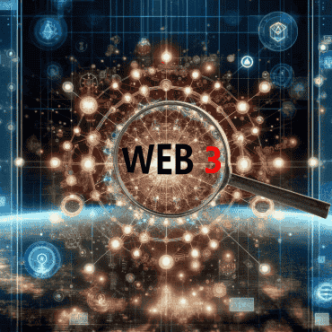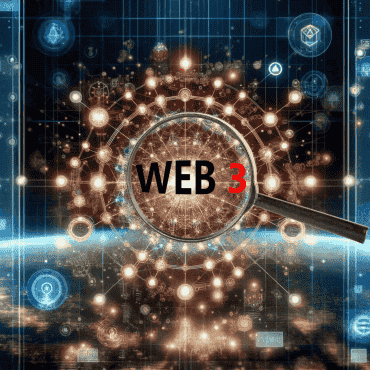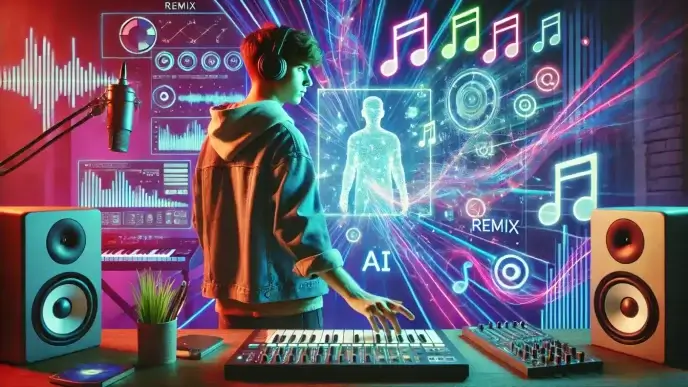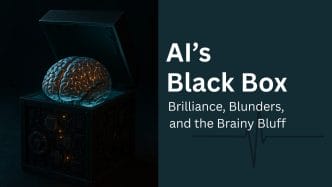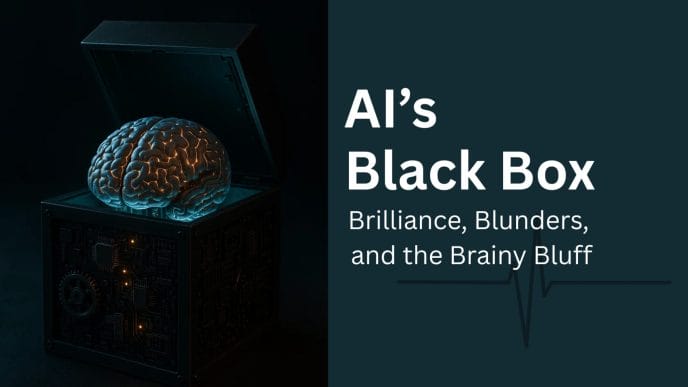The history of the internet has seen substantial advancements and technological innovation. It has changed from static web pages with some data-sharing capabilities to a place where many people are connected to each other, sparking ideas and facilities for many services.

Source: DFinity
However, the degree of power concentration of the internet, largely known as ‘Web 2.0’ in today’s world, is in the hands of only a few big tech companies that amass huge user data and content.
The evolution of the internet as we know it is characterized by Web 3.0 which includes decentralization and provision of control to users as well as creating new dimensions of creation and engagement.
This article delves into the detailed definition of Web3, its mechanics, and its potential impact on modern society and technology.
The Evolution of the Internet
The saga of the transformation of the World Wide Web kicked off with Web 1.0, laying the foundation for more advanced versions of the Web.
Web 1.0 – The Static Web
Web 1.0 is also known as the read-only web which can be assessed as the most basic version of the internet containing mainly static web pages. The pages contained information that could be accessed but not actively engaged with. Websites were very rudimentary and were akin to brochures or an information directory. There was no room for the individual to move content around or for content to be themed.
Here is a snapshot from a Web 1.0 website.
 Source: CNN
Source: CNN
It was simply the reading of the content posted on a website and Web 1.0 was devoid of comment boxes for readers or contributions by the readers.
Web 2.0 – The Interactive Web
There was a stark contrast when Web 2.0 came into effect. This period spanning from the early 2000s saw the advent of a higher level of interactivity. Websites such as Facebook, YouTube, and Twitter found their way around encouraging content creation and interaction.
Simply put, content was now a two-way affair, and the web was bombarded with the uptake of content from the users.
Take a look at this snapshot from a Web 2.0 blog site.
 Source: A Day in The Life
Source: A Day in The Life
When users started contributing content online, there was a catch. Excessive concentration of the online space was taken over by corporations such as Google, Facebook, and Amazon which began amassing user information and paradoxically selling it to advertisers or service providers.
Thus, while Web 2.0 empowered the people in terms of connecting and developing content, it placed the power into the hands of a small few.
Web 3.0 – The Decentralized Web
Web 3.0, which is usually termed Web3, is the next version of the internet, which aims to resolve the centralization issues in Web 2.0. It may come to you as a surprise but Web3 is based and developed on decentralized networks, more often than not on blockchain technology.
It purports to provide for all the users the capability of managing their data and assets without the use of third parties like social networks and banks. In Web3, users can both create and own the content and assets as it is a non-centralized inter-user system.
What is Web3?
Basically, Web3 refers to the internet that is built on a decentralized infrastructure. Such an infrastructure, typically based on blockchain technology, allows for decentralized exchanges with no need for tech organizations, banks, or other trusted third parties.
It’s one where you don’t have to pay a fee to some third party company, where you can have the data, where you can exchange digital assets and speak with anybody without intermediates.
Decentralization
Turned back to the situation with Web 2.0; all the content is hosted by some company on their own servers. Though Web3 is, in essence, an Internet where data control is abandoned; dismantled, and certainly over-control is exercised through the decentralization of technology bridges.
 Source: Blaize Tech
Source: Blaize Tech
This characteristic feature reinforces the network’s democratic principles by preventing any one central authority from monopolizing control over its operations, enhancing the level of transparency, safety, and resistance to censorship.
Blockchain Technology
Blockchain is the technology responsible for one of the significant improvements brought forth by Web 3.0, where transactions can be documented in a network without the burden of third parties.
Blockchains are, in effect, distributed databases that use packet-switched networks to capture the activities of all computers that help run the Blockchain network.
These records are kept using cryptographic techniques and are therefore very difficult to disrupt. One of the upsides of Web 3.0 is that its foundations are built on powerful blockchains like Ethereum and Bitcoin.
Smart Contracts
Smart contracts can be described as computer programs that can self-activate the terms of an agreement that are directly written into code. These contracts are self-fulfilling, only requiring that conditions are satisfied and the transactions are processed without third parties.
Here is a quick explainer video of a smart contract.

The smart contracts act as a fundamental aspect of Web3 because they help the decentralized applications (dAPPs) to continue working without interference.
Cryptocurrencies and Tokens
The transactions in Web3 occur with the use of virtual currencies without using banks and other financial institutions. A cryptocurrency is a digital currency and it is not dependent on a financial body, a token is a digital currency that represents anything ranging from ownership in a decentralization project to even pieces of digital art.
When sourced together they provide the economic structure that is Web3, allowing users to transfer value in a safe and peer-to-peer manner.
Key Features and Technologies Driving Web3
Laying the foundation of Web3’s innovations, some staggering features and technologies empower users by decentralizing control and ownership.
Decentralized Applications (DApps)
DApps are applications that are developed on the decentralized network Ethereum. DApps do not depend on one hosted server like every other application does, but rather operate on a network of computers, specifically on a blockchain.
These applications give the users more power since they do not depend on the internal institutions which manage and operate the application. Besides that, governance of dApps is possible by communities through decentralized autonomous organizations (DAOs).
For example: Uniswap is a decentralized exchange (DEX) that allows participants to swap digital assets without third parties’ assistance and create markets over coins and other confidential assets.
Decentralized Finance (DeFi)
The use of this technology brings new horizons as compared to traditional financial services, as DeFi-enabled forms of trading arise. How is it possible? Well, there isn’t a need for unity of a management structure but core knowledge – offering lending, borrowing, and trading services without any intermediaries.
Key platforms: Aave, Compound, and MakerDAO are examples of the DeFi protocols where users can stake or lend their crypto assets and borrow decentralized loans.
 Source: MakerDAO
Source: MakerDAO
Non-Fungible Tokens (NFTs)
NFTs are unique digital collectibles that signify possession of an item or content of any form, such as art, music, or video game assets. They have become extremely popular in the current times because they can potentially appeal to different kinds of audiences in various industries, such as arts, gaming, or entertainment which are all asset-backed.
For example: These encompass transactions by standard eCommerce websites with NFTs being digital and representing unique assets like images, and physical or virtual properties, or even interactions with social galleries like OpenSea and Rarible.
Challenges Facing Web3
Despite the immense potential of Web3’s offerings, it continues to face several obstacles that must be adhered to. Only then will the wide adoption of Web3 become a reality along with a seamless user experience.
Scalability Issues
Though blockchain is already a secure and distributed technology, it has challenges of scalability. Ethereum network for example has a limit to the transactions that can be made as well as other networks and this leads to high costs and congestion during periods of high traffic.
Rapid development is underway utilizing Ethereum 2.0 and other layer-2 scaling solutions to resolve this concern.
User Experience
In its current form, Web3 is not easy for the average person to embrace. The initial experiences involve installing a cryptocurrency wallet, controlling a private key, and interacting with a dApp which is quite overwhelming.
However, bringing such together will require a lot of great emphasis on enhancing the user experience so that mass reliance is achieved.
Regulation
The regulatory status of Web3 still remains ambiguous. Different countries are still trying to figure out the appropriate way of providing legal status to distributed systems and cryptocurrencies.
The ambiguity in regulation might hinder several aspects of Web3 including widespread adoption.
Security Risks
Although blockchain technology is relatively safe in terms of prying eyes, it cannot be said there are no dangers. Some decentralized smart contracts are vulnerable to attacks and DeFi phenomena hacks; with exploits happening now and then. So, users have to be careful while using Web3 services and tech.
The Future of Web3
As Web3 is still evolving, the future largely depends on the advancements that will enhance connectivity and collaboration across decentralized platforms.
Interoperability
Interoperability is one of the key things that is necessary for Web3 to attain its full benefits. This means that there is a need for different chains and other different decentralized platforms to interface or interlink with each other.
 Source: Polkadot
Source: Polkadot
Projects like that of Polkadot and Cosmos aim at building networked environments in which chains can be independent and cooperative at the same time.
 Source: Cosmos
Source: Cosmos
Potential Impact on Industries
Countless industries will be transformed by Web3. For example, in the case of finance, DeFi can take over the banking industry. In the styling of the function of media and entertainment, NFTs can change the perspective of how artists and creators monetize their craft.
Governance as well can change whereby decision-making can be decentralized with the use of DAOs.
Long-Term Vision
In the long term, Web3 will create an open internet where the users have absolute power over their data, digital assets, and activities. Such an internet will not be controlled by any single corporation or government entity hence building a more user-friendly, open and transparent economy.
Summing Up
The web as we know it is set for a dramatic redesign, which helps us understand how Web3 works. Reducing the concentration of networks and giving control to users entails creating Web3 which is much better and fairer.
Although there are some challenges such as regulations, user experience, and scalability which can make us wonder further than a decentralized web, its potential is great.
Whether it is improved control over personal information, new prospects for earnings via decentralized finance, or capitalizing on voices or needles, a new digital era presents itself to us thanks to Web3. Now is the time to keep learning and see how the next stage of the internet can influence our lives and businesses.
____________
Written By: ISHAN BARMAN
